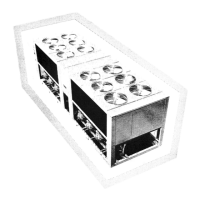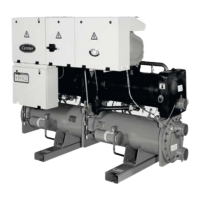Sequence of Operation
30MP Multi-chiller CARRIER CORPORATION ©2018
Installation and Start-up Guide All rights reserved
23
You can change the occupancy source to one of the following:
•
The controller is occupied 24/7 until you configure a time schedule using the Equipment Touch, Field
Assistant, or the i-Vu® application, or until a third party control system
the
point. You can disable this by going to
>
>
and
changing the point from
to
and clicking
.
You must
this point in order for the Equipment Touch, Field Assistant, or the i-Vu® application
to assign a time schedule to the controller.
•
The unit operates according to the schedule configured and stored in the unit. The schedule is accessible in
the Equipment Touch, Field Assistant, or the i-Vu® application. The daily schedule consists of a start and stop
time (standard or 24 hour mode) and seven days of the week, starting with Monday and ending on Sunday.
•
(optional)
If configured for remote occupancy control (default), the controller can use an external dry contact closure to
determine the occupancy status of the unit. Disable the
to use the occupancy contact
input.
Scheduling can only be controlled from one source.
•
BAS (Building Automation System) On/Off
For use with a Building Automation System that supports network scheduling, you must disable the
so the BAS can control the unit through a network communication and the BAS
scheduling function.
Scheduling can either be controlled from the unit or the BAS, but not both.
•
Uses the network to obtain an occupancy status value from another controller, which is read over the network
and used by this controller.
MUST be set to
to use this function.
Scheduling can only be controlled from one source.
The 30MP Multi-chiller can provide up to 3 stages of demand limiting, if connected to an electric metering
program indicating that demand limiting is required.
Demand Limiting works using 2 different methods. The first connects the BACnet network input point
to the electric metering program, to send a value for the demand level. The second method is a
binary input point BI-5
that sets the demand level to level #2 when the input is active.
Demand Level 1, called the red line limit, sets the maximum chiller capacity to the current operating capacity, so
that no additional capacity can be added. This prevents further increase in demand, although it will not prevent
any necessary capacity reduction.
Demand levels 2 and 3 provide an adjustment to the operating setpoint. Demand level 2 occurs when
is set to 2 or the
input is active. This increases the chilled water setpoint by
the configured
amount. Demand Level 3 occurs when
is set
to 3. This increases the chilled water setpoint by the configured
amount. If the
is set to 0 and the BI-5
is inactive, then there is no demand limiting.

